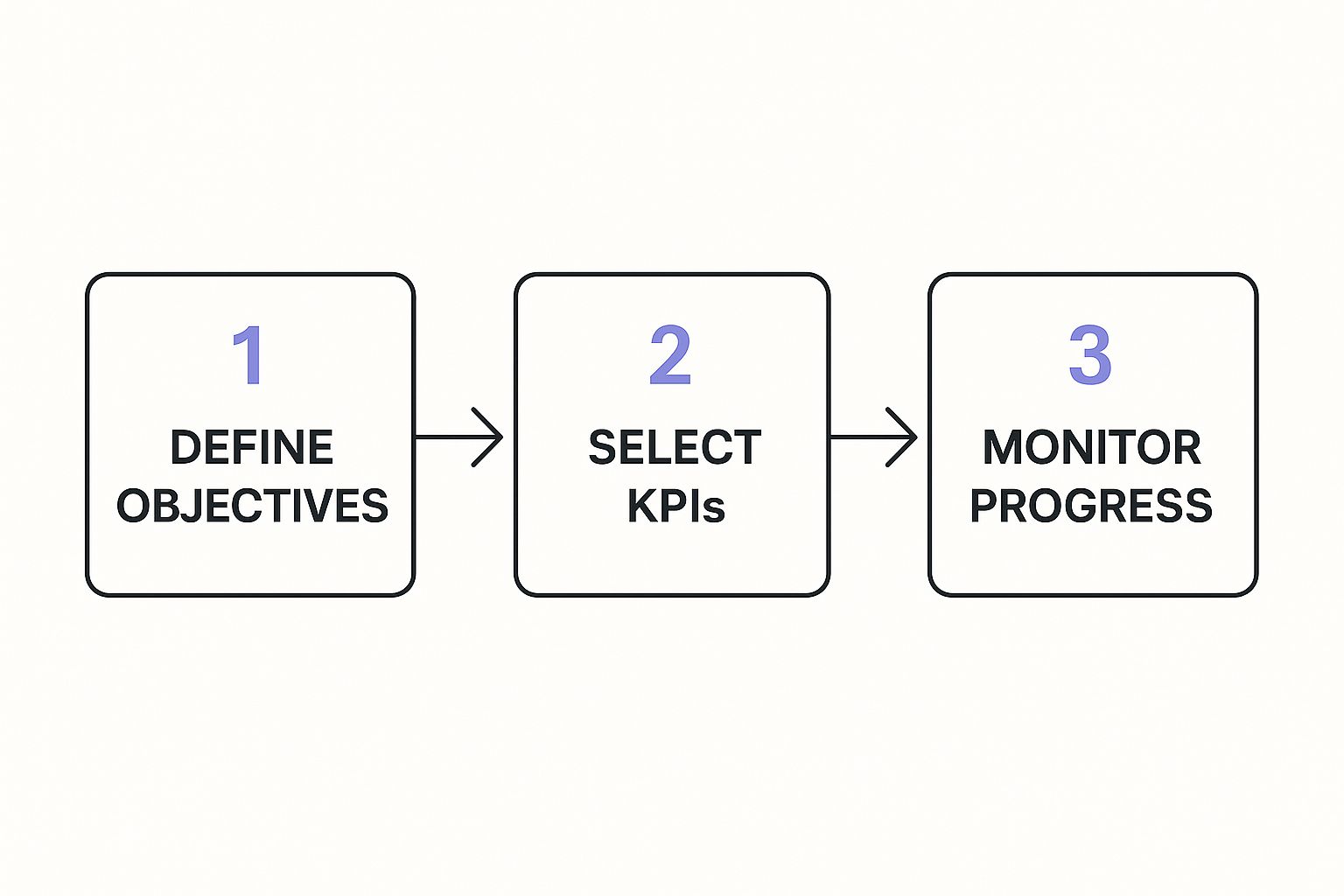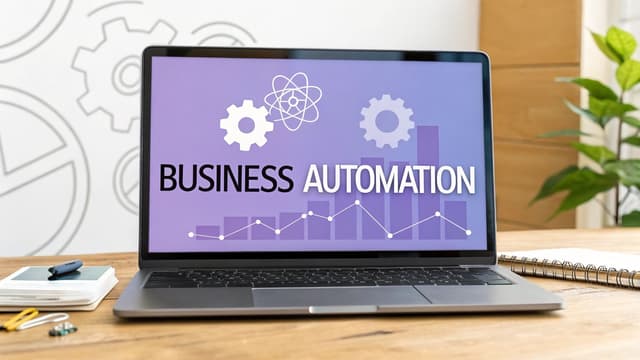A digital transformation roadmap is far more than just a plan. Think of it as a strategic guide that lays out exactly how your business will evolve, using technology to hit its most important goals. It takes a massive, company-wide change and breaks it down into a series of manageable, interconnected initiatives.
This approach stops you from getting lost in buzzwords and makes sure every single action has a clear purpose. Without this guide, digital efforts often become disjointed, expensive, and, frankly, ineffective.
Why Your Business Needs a Roadmap Now

Trying to operate without a digital transformation roadmap is like navigating a storm without a compass. With constant market pressures, shifting customer expectations, and dizzying technological advancements, a reactive strategy just doesn't cut it anymore. It’s a recipe for falling behind.
I've seen it happen. Think about a regional logistics company trying to compete against national giants. Without a plan, they might invest sporadically—a new app here, a software update there—with no real synergy. This piecemeal approach burns through resources and delivers minimal impact.
Now, picture that same company with a clear roadmap. They identify a core goal: improve customer reliability. This single objective then drives a series of connected projects, from moving to a cloud-first infrastructure to using AI for predictive maintenance. Each step is a deliberate move toward a larger strategic vision, not just a frantic reaction to a problem.
From Survival to Strategic Growth
A roadmap reframes digital initiatives from a necessary cost into a powerful investment in your company's future growth and resilience. It gets every department—from IT to marketing to operations—aligned and pulling in the same direction.
Here’s a real-world contrast I often see with retail businesses:
- Company A (No Roadmap): They launch an e-commerce site because "everyone has one." It’s totally disconnected from their in-store inventory system, leading to constant stock-outs online and seriously frustrated customers.
- Company B (With a Roadmap): They identify "creating a seamless omnichannel experience" as a key goal. Their new e-commerce platform is just one piece of a larger initiative that includes integrated inventory management and AI-powered customer support, like FlowGent AI, to handle order inquiries across every channel.
Company B isn't just surviving; it's building a foundation for incredible customer loyalty and long-term market relevance.
A common failure point is viewing digital transformation as a purely technological project. In reality, it’s a business strategy enabled by technology. The roadmap ensures this alignment is never lost.
The urgency here is backed by massive market momentum. The global digital transformation market is projected to skyrocket from USD 1.42 trillion in 2025 to a staggering USD 13.26 trillion by 2035. This explosive growth shows that your competitors aren't waiting around; they are actively investing in structured, strategic change.
Core Components of a Successful Roadmap
To build an effective roadmap, you need to ground it in a few essential pillars. This table breaks down what those pillars are, what they focus on, and a quick example to bring it to life. It's a great reference for making sure you've covered your bases.
| Pillar | Key Focus | Example Goal |
|---|---|---|
| Business Vision & Goals | Aligning technology with core business objectives. | "Increase customer lifetime value by 20% in two years." |
| Customer Experience | Improving every touchpoint a customer has with your brand. | "Reduce average customer support response time by 50%." |
| Operational Efficiency | Automating and optimizing internal processes. | "Automate 80% of manual data entry in the finance department." |
| Technology & Infrastructure | Building a scalable, secure, and modern tech stack. | "Migrate 75% of on-premise servers to the cloud by Q4." |
| People & Culture | Fostering skills, adoption, and a digital-first mindset. | "Train all customer-facing staff on the new CRM system." |
A roadmap built on these components ensures you're looking at the transformation holistically, not just as an IT project.
Building a Foundation for Success
Ultimately, a digital transformation roadmap provides the clarity you need to make tough decisions. It helps you prioritize initiatives based on impact versus effort, letting you score quick wins while steadily building toward your long-term vision. For a structured approach, using a comprehensive digital transformation roadmap template can be a game-changer.
It forces you to answer the hard questions before you spend a single dollar:
- What specific business problem are we actually solving?
- How will we know if this was successful? What are the metrics?
- What processes and roles need to change to support this new technology?
Answering these questions transforms abstract goals into concrete, actionable steps. This kind of structured thinking is the true difference between a transformation that drives revenue and efficiency, and a costly initiative that fails to deliver on its promise.
Building Your Strategic Foundation
 A powerful digital transformation roadmap doesn't kick off with a shopping list of new technologies. It starts with an honest, unflinching look at where your business is right now. This discovery phase is the bedrock of your entire strategy, and skipping it is a recipe for failure.
A powerful digital transformation roadmap doesn't kick off with a shopping list of new technologies. It starts with an honest, unflinching look at where your business is right now. This discovery phase is the bedrock of your entire strategy, and skipping it is a recipe for failure.
You need to roll up your sleeves and do a thorough audit of your current state—your processes, systems, and team capabilities—to find the real bottlenecks and untapped opportunities.
From there, every single transformation goal must tie directly back to a core business objective. Are you trying to boost market share, improve customer loyalty, or slash operational costs? That connection needs to be crystal clear. This isn't just about brainstorming; it's about making data-driven decisions that will actually move the needle for the business.
Conduct a Thorough Current-State Audit
Before you can plan where you're going, you have to know your starting point. A comprehensive audit gives you this clarity. I'm not talking about a simple inventory of your tech stack; this is a deep dive into how work really gets done in your organization.
Start by mapping out key operational workflows. For example, how does a customer order move from placement to fulfillment? How are support tickets handled from the moment they're submitted to when they're finally resolved? Documenting these flows often reveals surprising inefficiencies and manual workarounds that have become bad institutional habits.
You might find your sales team is burning 10 hours a week manually copying data between your CRM and a spreadsheet simply because the two systems don’t talk to each other. That’s a perfect, tangible problem you can solve. For more inspiration, check out these practical business process automation examples that show how to eliminate these kinds of soul-crushing tasks.
Align Transformation Goals with Business Objectives
Your roadmap's initiatives should never exist in a vacuum. Each one must be a direct answer to a strategic business need. Getting this alignment right is absolutely critical for securing executive buy-in and keeping the project's momentum alive.
So, instead of a vague goal like "improve customer service," define a specific, measurable business outcome. A much stronger objective would be: "Reduce customer churn by 15% within 18 months by improving our first-contact resolution rates."
This approach connects the dots for everyone. Suddenly, implementing an AI-powered support tool like FlowGent AI isn't just a tech project—it's a strategic move to directly impact customer retention and revenue. To get this right, it helps to follow a practical 4-step guide for businesses to stay ahead with AI.
Here's the key takeaway: technology serves the business, not the other way around. If you can’t draw a straight line from a proposed digital initiative to a core business goal, it doesn't belong on your roadmap. Simple as that.
Assemble Your Team and Define Success Metrics
Digital transformation is a team sport. It's not a solo mission led by the IT department. Building a dynamic, cross-functional team isn't just a nice-to-have; it's a non-negotiable step for creating a strategy that actually works.
Your team should include people from every key department affected by the changes:
- Operations: They live and breathe the ground-level workflows and know all the pain points.
- Marketing: They own the customer's voice and can point out gaps in the experience.
- Sales: They're on the front lines and can identify friction in the buying journey.
- Finance: They can help you build the business case and, crucially, track the ROI.
- IT: They bring the technical expertise to assess what's feasible and how it all integrates.
Once the team is in place, your next job is to define the Key Performance Indicators (KPIs) that will tell you if you're winning. These metrics have to be established before the project kicks off to create a clear benchmark for performance.
Examples of Strong KPIs for a Digital Roadmap:
| Business Goal | Transformation Initiative | Primary KPI |
|---|---|---|
| Increase Operational Efficiency | Automate invoice processing | Time to process an invoice (reduction in hours) |
| Enhance Customer Engagement | Deploy 24/7 AI chat support | Customer Satisfaction Score (CSAT) |
| Boost Lead Generation | Implement a new CRM | Lead-to-conversion rate |
Defining these KPIs from day one does more than just track progress. It proves the value of your roadmap at every stage and shifts the conversation from costs to outcomes—which is essential for keeping everyone bought in and excited for the journey ahead.
With your strategy locked in, it's time to get your hands dirty. This is where the high-level vision gets translated into actual projects your team can sink their teeth into. We're moving from "what" and "why" to "who," "how," and "when."
The goal here isn't to boil the ocean. You're building a prioritized sequence of initiatives designed to deliver value quickly and build momentum. This means you need a smart way to decide what to tackle first, second, and so on.
A Practical Way to Prioritize
Forget about gut feelings. One of the best, most objective ways I've seen teams do this is with a simple impact/effort matrix. It's a powerful tool that forces you to have the right conversations and make decisions based on more than just who shouts the loudest.
For every potential project on your list, you'll evaluate it against two simple questions:
- Impact: How much will this actually help us hit our main goals? Will it drive revenue, make customers happier, or boost efficiency?
- Effort: Realistically, what will this cost us in terms of time, money, and people?
This exercise cuts through the noise and brings incredible clarity to the planning process. It helps you sort your ideas into buckets so you can build a roadmap that is both ambitious and achievable.
How to Group Your Projects for Maximum Momentum
Once you've run your initiatives through that matrix, you can group them into four buckets. This gives your roadmap structure, ensuring you're banking some quick wins while still making progress on the big, game-changing stuff.
| Category | Description | How to Approach It |
|---|---|---|
| Quick Wins | High Impact, Low Effort | Do these now. These are your momentum-builders. They boost morale and show everyone that this transformation is real and delivering value. |
| Major Projects | High Impact, High Effort | Plan these carefully. These are the big strategic bets that need serious planning, resources, and stakeholder alignment. |
| Fill-Ins | Low Impact, Low Effort | Do them if you have time. These are nice-to-have improvements. Tackle them when you have a spare moment, but don't let them distract you. |
| Reconsider | Low Impact, High Effort | Avoid these. These are resource drains. They eat up time and money for very little return. Cut them loose. |
Think about it in real-world terms. An e-commerce business might classify implementing an AI-powered customer support tool like FlowGent AI as a quick win. It has a huge, immediate impact on customer happiness and is fairly low-effort to get up and running—especially compared to a complete ERP system overhaul, which is clearly a major project.
This is the foundational flow for setting and measuring your transformation goals.

The image lays it out perfectly: define your goal, pick the right metrics to track it, and then constantly check your progress. It’s a simple, powerful loop.
Building a Timeline That Actually Works
With your priorities straight, you can start laying out a timeline. But here’s a critical tip: don't create a rigid, five-year plan that will be obsolete in six months. Think in phases instead.
- Phase 1 (The First 12-18 Months): Get super detailed here. This is your action plan. List the specific projects, assign clear owners, lock in budgets, and set quarterly milestones.
- Phase 2 (Years 2-3): This part can be more about direction. Outline the bigger strategic themes and initiatives you see on the horizon. It gives you a long-term view without sacrificing the agility you need right now.
It’s sobering, but we have to acknowledge the reality: most transformation projects fail. Reports show that only about one-third of companies actually achieve their digital transformation goals. This isn't to scare you, but to stress just how important a well-designed and properly prioritized roadmap is.
Your roadmap is a living document, not a stone tablet. It has to be reviewed and adjusted regularly—at least quarterly—to react to market shifts, new tech, and the lessons you learn from your own work.
As you build this out, consider using some of the excellent tools for building a product roadmap. They can help you visualize everything and keep all your stakeholders on the same page.
Nailing Down Resources and Risks
Finally, no project gets a spot on the roadmap without a clear-eyed look at resources and risks. For every single initiative, you need to ask:
- Who owns this? There needs to be one person who is ultimately accountable.
- What's the budget? Be specific. This includes the tech itself, implementation costs, and crucial things like training.
- What could go wrong? Think about potential roadblocks. Are there tricky technical integrations? Will employees resist the change? Does this project depend on another one finishing first?
For instance, migrating your CRM to a new platform involves obvious technical risks (what if the data migration fails?) and people risks (what if no one adopts the new tool?). By flagging these upfront, you can build a plan to deal with them—like adding extra time for data validation or investing in a solid change management program.
This kind of foresight is what turns an ambitious roadmap into a realistic, achievable plan.
Navigating Implementation and Change
This is where the rubber meets the road. All your strategy sessions, audits, and meticulous planning finally come to life. But here’s the thing: success isn't just about the tech. The most critical—and honestly, the most overlooked—factor is the human one.
Implementation isn't a straight line. It's a dynamic process that demands flexibility, forcing you to learn and pivot as you go. This is precisely why agile methods are so effective here. They help you keep everything on track without bringing your daily business operations to a screeching halt.
The real mountain to climb, though, is change management. It’s one thing to give your team a new tool; it’s another thing entirely to get them to genuinely embrace a new way of working. This takes deliberate, clear communication, targeted training, and a culture that sees innovation as a leg up, not a threat.
Fostering a Culture of Adaptation
Let's be blunt: the most brilliant, technically perfect system will crash and burn if your team resists it. The "why" behind any change is just as important as the "what." You have to craft a compelling story that ties every new initiative back to a real benefit—for both the company and the individual.
For instance, don't just announce, "We're automating invoicing." That sounds like a pink slip.
Frame it this way: "We're getting rid of the 3 hours of manual data entry you do each week. That frees you up to focus on deeper analysis and build stronger client relationships." See the difference? It shifts the narrative from replacement to empowerment.
Resistance is normal. In fact, you should expect it. Don't shut it down; treat it as free consulting. A skeptical team member often has a ton of institutional knowledge and might be pointing out a genuine flaw in your plan. Hear them out and, better yet, pull them into the process of finding a solution.
A critical mistake is assuming employee buy-in will happen automatically. Change management is not an afterthought; it should be a dedicated workstream within your implementation plan, with its own resources and milestones.
I've personally seen the most skeptical employees become a project's biggest champions. Once they feel heard and see how a new tool genuinely makes their jobs better, they flip. They go from being roadblocks to being your most powerful internal advocates, training their peers and generating real enthusiasm.
Practical Strategies for Managing Change
To get through this, you need more than a company-wide memo. You need a structured, human-centered approach built on consistent action.
Here are a few strategies that have never failed me:
- Communicate Early and Often: Don't spring things on people. Start sharing the vision and the "why" from day one. Use every channel you have—town halls, team meetings, newsletters—to make sure the message lands.
- Invest in Hands-On Training: Nobody learns from a PowerPoint deck. Set up real, hands-on training sessions customized for different roles. Let people play around in a safe "sandbox" environment before they have to use the new system for their actual job.
- Establish a Feedback Loop: Make it incredibly easy for employees to ask questions, flag issues, or offer ideas. This could be a dedicated Slack channel, regular "office hours" with the project team, or even a simple feedback form.
Think about rolling out a new AI-powered support tool. The customer service team's first thought is likely, "Is this bot going to replace me?" Your change management plan needs to tackle this head-on. Show them how the AI handles the boring, repetitive queries, which frees them up to solve the complex, high-value customer problems that require a human touch.
Keeping the Project on Track
While you're managing the people side, the technical implementation has to keep moving. This is where agile principles are a lifesaver. Instead of a risky "big bang" launch where everything changes overnight, break the project into smaller, digestible sprints.
For example, if you're deploying a new CRM:
- Sprint 1: Start with a small pilot group, like the core sales team. Migrate only their active leads and contacts.
- Sprint 2: Gather their feedback, fix what's broken, and then roll it out to the customer support team.
- Sprint 3: Now, integrate it with your marketing automation platform.
This phased approach is just common sense. It minimizes risk. If something goes sideways in the first sprint, it only affects a small group and you can fix it before it impacts the entire company. It also lets you show progress and deliver value quickly, building momentum and confidence along the way.
A huge part of this is mapping out how new technologies change existing workflows. This is a core component of effective customer journey orchestration. When you intentionally connect the technology with the human experience, you create a much smoother, more successful transition.
How to Measure Success and Evolve Your Roadmap

Here’s a hard truth: a digital transformation roadmap isn't a document you frame and hang on the wall. It’s a living guide. It has to breathe and adapt right along with your business. The final—and most critical—part of this journey is building a solid system to measure what’s working and adjust your strategy based on real results.
This is where you come full circle, back to those Key Performance Indicators (KPIs) you hammered out in the beginning. Without a real commitment to tracking and analysis, you're just flying blind. You can't prove the value of your investments or make smart calls on what to do next. Success isn't just launching shiny new tech; it's about seeing that tech deliver tangible, bottom-line outcomes.
Establishing Your Measurement Framework
To get a true read on your progress, you need a mix of hard numbers and human feedback. Relying on one without the other gives you a dangerously incomplete picture. Sure, a new system might boost efficiency metrics on paper, but if your team hates using it and morale plummets, you've just created a new, expensive problem.
Your measurement framework should center around a performance dashboard. And I don't mean a messy spreadsheet. Think of it as a visual command center, pulling data from multiple sources to give leadership a real-time snapshot of your roadmap's impact.
A good dashboard should include:
- Quantitative Metrics: The hard numbers that are easy to track. Think cost savings, productivity gains, or higher sales conversions.
- Qualitative Feedback: The human side of the story. These are insights from surveys, interviews, and feedback sessions that gauge things like customer satisfaction and employee morale.
- Progress vs. Milestones: A transparent view of where every project stands against its original timeline and budget.
The real goal here is to move past vanity metrics. A jump in website traffic looks great in a report, but if it doesn’t lead to more qualified leads or better customer retention, it’s not a meaningful win for your transformation.
The global investment in these initiatives is staggering. In 2023, the US alone accounted for 35.8% of worldwide digital transformation spending, with Western Europe at 22.7% and China at 16.8%. With that level of spending, you have to prove a return on investment.
Conducting Regular Review Sessions
Data is absolutely useless if you don't act on it. You need to schedule regular, mandatory review sessions with your cross-functional team. I’ve found that a quarterly cadence works best. These aren't just status updates; they are strategic working sessions with a clear, focused agenda.
The point of these meetings is to:
- Assess Progress: Look at the dashboard and KPIs. Are you hitting the targets you set? If not, it's time to dig in and understand why.
- Identify Roadblocks: What's slowing you down? Is it a technical glitch, a cultural hurdle, or a simple lack of resources?
- Adapt and Re-Prioritize: Based on the data and any market shifts, what needs to change? Maybe you need to accelerate one project, put another on pause, or pivot your approach completely.
Let’s say you launched an AI support agent. The data shows a 40% drop in ticket volume (great!) but also a 10% dip in your Customer Satisfaction (CSAT) score (not so great). Your review session should become a deep dive into that specific problem. You might find the AI needs better training on complex questions, which gives you a clear, focused initiative for the next quarter. Understanding the full benefits of AI in customer service helps frame these discussions and set the right expectations.
Key Metrics for Measuring Roadmap ROI
To really prove the value of your digital transformation roadmap, you need to track specific KPIs across different parts of the business. You can't just look at one area and declare victory. This table gives you a solid starting point for what to measure to demonstrate a clear return on your investment.
Key Metrics for Measuring Roadmap ROI
| Business Area | Example KPI | Measurement Tool/Method |
|---|---|---|
| Operations | Cycle Time Reduction | Process mining software or ERP reports |
| Customer Service | First Contact Resolution (FCR) Rate | Helpdesk or CRM analytics |
| Sales & Marketing | Customer Lifetime Value (CLV) | CRM and financial system data |
| Human Resources | Employee Adoption Rate of New Tools | Software usage analytics |
| Finance | Reduction in Operational Costs | Financial reporting software |
This continuous cycle of measuring, analyzing, and adapting is what turns your roadmap from a static plan into a dynamic engine for growth. It’s this iterative process that keeps your organization agile, resilient, and ready for whatever comes next.
Answering Your Toughest Digital Transformation Questions
Even with a perfect plan on paper, a digital transformation roadmap can feel like a monumental task. It’s completely normal for questions to bubble up as you shift from high-level strategy to the nitty-gritty of execution. Having solid answers to these common worries is key to keeping your team aligned, confident, and laser-focused on the goal.
Let's dive into some of the most frequent questions I hear from leaders who are in the thick of creating and rolling out their roadmaps. Think of this as your quick-reference guide to sidestepping common pitfalls and keeping your strategy sharp.
How Long Should a Digital Transformation Roadmap Be?
This is the big one, and honestly, there's no single magic number. The trick is to strike a balance between a bold long-term vision and concrete, near-term actions.
I've found the most effective approach is to sketch out a 3 to 5-year strategic direction but build a super-detailed, granular plan for the first 12 to 18 months.
That initial 12-to-18-month window is your action plan. It absolutely must include:
- Specific Projects: Clearly defined initiatives with real start and end dates.
- Designated Owners: A single person who is accountable for each project's success.
- Concrete Budgets: Locked-in funding for the tech, training, and people needed.
- Quarterly Milestones: Checkpoints to track progress and make smart adjustments.
For the later years (2 through 5), your roadmap can be more of a compass than a map. It should outline the major strategic moves you're aiming for, like "expanding into new markets" or "fully integrating AI across all operations." This gives you long-term ambition without killing the agility you need to react to market changes.
The most important thing to remember is that your roadmap is a living document. It's not a static plan you create once and then file away. You have to review and update it at least quarterly for it to stay relevant and effective.
What Is the Biggest Mistake Companies Make?
Without a doubt, the single costliest mistake I see is companies getting hyper-focused on technology while completely ignoring the people and processes. It’s an easy trap. Leaders get dazzled by shiny new software or a powerful platform and throw millions at it, assuming the tech itself is a silver bullet.
This approach almost always blows up in their faces.
Without a serious investment in change management, employee training, and redesigning the old workflows, that shiny new tech never delivers. You end up with frustrated teams, terrible adoption rates, and a complete failure to see any of the promised ROI.
A winning digital transformation has to give equal weight and resources to all three pillars: people, process, and technology. One simply can't succeed without the others.
How Do We Fund Our Digital Transformation Roadmap?
Funding a massive transformation project isn’t usually a single, giant check. It demands a smarter, more strategic approach to budgeting. The best funding models blend a few different tactics to create a financial plan that can actually last.
First, look at reallocating existing budgets. This is often the lowest-hanging fruit. Can you turn off old, expensive-to-maintain legacy systems and reroute that money toward modern, efficient solutions?
Next, you have to build a rock-solid business case for any new spending. Every funding request needs to be backed by a clear, data-driven projection of its return on investment (ROI). Connect the investment directly to a business outcome, whether that’s hitting a new revenue target, cutting operational costs, or boosting customer retention.
Finally, think like a portfolio manager. Fund a mix of initiatives:
- Quick Wins: These are low-cost, high-impact projects that deliver immediate value. The money saved or earned from these can help self-fund bigger projects later.
- Strategic Bets: These are the larger, foundational investments that are critical for your future but might take longer to pay off.
Getting your executive team on board means clearly showing how every single dollar you’re asking for connects to a real business result. That’s the key to unlocking the budget you need.
Who Should Own the Digital Transformation Roadmap?
While your CIO or CTO is obviously essential for the tech side, real ownership of the roadmap must sit in the C-suite—ideally with the CEO. Why? Because digital transformation is a business strategy enabled by technology, not just another IT project.
When ownership is delegated solely to the IT department, the plan almost always fails. The initiatives struggle to get buy-in across the company and end up misaligned with what other departments are trying to achieve.
The most effective structure I've seen is a cross-functional steering committee. This group should be led by a C-suite executive and must include leaders from key departments like operations, marketing, finance, sales, and HR. This setup guarantees the roadmap aligns with everyone's goals, builds widespread support, and holds every department accountable for its part in the journey.
Ready to stop answering repetitive questions and start delivering exceptional customer experiences? The AI agents from FlowGent AI can handle routine inquiries 24/7 across 95+ languages, freeing your team to focus on high-value work. Discover how FlowGent AI can transform your customer support.



